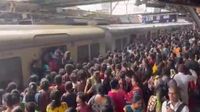On Thursday evening, November 6, 2025, Mumbai’s bustling local train network was brought to a sudden halt by a flash strike, setting off a chain of tragic events that left at least two people dead and three others injured near Sandhurst Road railway station. As commuters packed onto platforms and frustration mounted, a moment’s impatience turned fatal—a stark reminder of the razor’s edge on which India’s crowded railways often operate.
The drama began during the evening rush hour, just as lakhs of daily commuters were making their way home. According to NDTV and Republic World, Central Railway’s worker unions called a nearly hour-long flash strike at Chhatrapati Shivaji Maharaj Terminus (CSMT), Mumbai’s historic and busiest rail hub. From approximately 5:50 pm to 6:45 pm, all suburban train services ground to a standstill. The cause: a protest against a First Information Report (FIR) registered by the Government Railway Police (GRP) against two Central Railway engineers in connection with a fatal accident that had taken place months earlier near Mumbra.
The strike’s timing could hardly have been worse. With trains out of service during peak hours, platforms quickly became dangerously overcrowded. The Logical Indian and PTI reported that the mounting tension and confusion led some commuters to take risks they might otherwise have avoided. Five people, stranded for nearly an hour on the platform, decided to cross the tracks—an all-too-common but perilous shortcut in Mumbai’s rail system. As they attempted to make their way across, a fast local train bore down on them. The result was catastrophic: two people, identified as Hailey Mohmaya, 19, of Matunga, and Suryakant Naik, 45, from Mira Road, were killed instantly. Three others were injured, one of them critically.
Hospital officials at JJ Hospital confirmed, “Two persons were brought dead to the hospital, while three were injured. Of these, two took discharge against medical advice, while one is being treated at the facility.” The chaos and tragedy at Sandhurst Road station were a direct consequence of the service disruption, as many commuters, desperate to reach their destinations, risked their lives by crossing the tracks instead of using the foot overbridge.
The flash strike was not an isolated event, but the culmination of simmering tensions between Central Railway employees and the authorities. The immediate trigger was the FIR filed on November 1, 2025, by the GRP against Assistant Divisional Engineer Vishal Dolas, Senior Section Engineer Samar Yadav, and other officials. The charges stemmed from a June 9, 2025, accident near Mumbra, where eight people fell off two trains passing each other in opposite directions. Five died, and six were injured. The Central Railway’s own inquiry, as reported by The Indian Express, concluded that the accident was caused by a commuter’s large bag brushing against others on the footboard, triggering a domino effect. The report gave railway employees a clean chit, blaming no one for the tragedy.
However, the GRP’s investigation, supported by findings from the Veermata Jijabai Technological Institute (VJTI), took a different view. It alleged that negligence in track maintenance, a failure to carry out necessary repairs after heavy rains, and allowing trains to exceed the designated speed limit of 69.4 kmph (with some running at 75 kmph) all contributed to the accident. The FIR charged the engineers under sections related to culpable homicide not amounting to murder and acts endangering life and personal safety.
Railway officials were incensed. They argued that the FIR was not based on proper facts and that VJTI was not technically equipped to probe such incidents. In their view, the charges were unfair and scapegoated railway staff for systemic issues. As one official stated, “The FIR was not based on proper facts, and VJTI was not technically equipped to probe the incident.” The unions warned of industrial action, and on Thursday evening, they followed through, bringing Mumbai’s central rail artery to a halt and unleashing chaos at the city’s stations.
As the dust settled, the incident near Sandhurst Road station was quickly recognized as part of a troubling pattern. Mumbai’s vast rail network, the lifeblood of the city, is no stranger to such tragedies. Overcrowding, impatience, and unsafe behaviors like track crossing lead to hundreds of deaths each year. Despite repeated safety campaigns and improvements, the underlying problems persist—exacerbated during disruptions like Thursday’s strike.
The events in Mumbai also echoed a series of deadly train accidents across India in 2025. According to The Logical Indian, earlier in November, a passenger train collided with a stationary freight train near Bilaspur, Chhattisgarh, killing at least 11 people. In Mirzapur, Uttar Pradesh, six people died crossing the tracks during a religious event. Nationwide, derailments and collisions have resulted in dozens of deaths and injuries, highlighting the urgent need for modernization and reform in India’s aging railway infrastructure.
The clash between workers’ rights and commuter safety has rarely been so stark. Central Railway employees, for their part, argue that they are being unfairly targeted for systemic failures beyond their immediate control. The unions’ flash strike was a bid to draw attention to what they see as scapegoating by the authorities. Yet, as The Logical Indian editorialized, “The loss of three lives in avoidable circumstances is a somber reminder that safety must never be compromised, regardless of operational challenges.”
In the aftermath, senior railway officials assured protesting workers that they would take up the matter with the Maharashtra state administration. Train services resumed at CSMT by 6:45 pm, but the damage had been done. The city was left to mourn the loss of life and grapple with questions about accountability, infrastructure, and the daily risks faced by millions of commuters.
The Sandhurst Road tragedy has reignited debate over the responsibilities of railway management, the adequacy of safety protocols, and the broader need for investment in India’s railways. Calls for compassionate dialogue among stakeholders have grown louder, with many urging urgent collective efforts to strengthen infrastructure, raise public awareness, and ensure that the rules are respected by all. Only through such measures, advocates argue, can Mumbai’s trains be made truly safe for the millions who depend on them every day.
For a city that lives and breathes by its rails, Thursday’s events were a grim warning: when safety and accountability fall through the cracks, it’s the commuters who pay the ultimate price.

